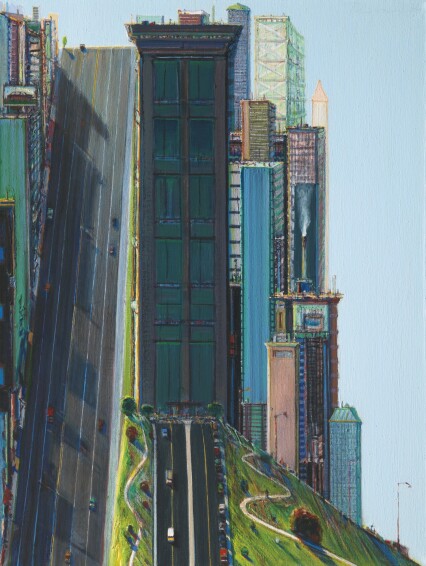- 6
Wayne Thiebaud
Description
- Wayne Thiebaud
- Hill Street (Day City)
- signed and dated 1981; signed and dated 1981 on the reverse
- oil on canvas
- 48 x 36 1/8 in. 121.9 x 91.7 cm.
Provenance
Mr. and Mrs. Richard Hedreen, Seattle
Acquired by the present owner from the above
Exhibited
San Francisco, Fine Arts Museum of San Francisco, California Palace of the Legion of Honor; Fort Worth, Modern Art Museum of Fort Worth; Washington, D.C., The Phillips Collection; New York, Whitney Museum of American Art, Wayne Thiebaud: A Paintings Retrospective, June 2000 - September 2001, cat. no. 73, p. 145, illustrated in color
Condition
In response to your inquiry, we are pleased to provide you with a general report of the condition of the property described above. Since we are not professional conservators or restorers, we urge you to consult with a restorer or conservator of your choice who will be better able to provide a detailed, professional report. Prospective buyers should inspect each lot to satisfy themselves as to condition and must understand that any statement made by Sotheby's is merely a subjective qualified opinion.
NOTWITHSTANDING THIS REPORT OR ANY DISCUSSIONS CONCERNING CONDITION OF A LOT, ALL LOTS ARE OFFERED AND SOLD "AS IS" IN ACCORDANCE WITH THE CONDITIONS OF SALE PRINTED IN THE CATALOGUE.
Catalogue Note
Hill Street (Day City) is aptly titled as a prime exemplar of the precipitous terrain of Thiebaud’s San Francisco environs and the luminosity of the Pacific light of the Bay area, paralleling the other great series of California cityscapes, Richard Diebenkorn’s Ocean Park paintings. Aside from one sojourn in New York City in the 1950s, Thiebaud lived and worked in the Golden State, and observed firsthand the profound changes in post-war California, with its explosive urban growth and expanding automotive culture. His grasp of the vernacular of his surroundings informed the complex composition and spatial design of Hill Street (Day City). Balancing representation with abstraction, seriousness and wit, touch and control, Thiebaud painted urban scenes as aesthetic fantasies, almost surreal in their effect. The improbable geometry of the vertiginous streets and hills of the present work, bathed in a luminous glow, was the perfect forum in which to explore the opposing tensions between modern abstraction and classic representation. Initially working directly in the streets and intersections, Thiebaud experienced a breakthrough when he instead moved back into the studio to work with various series of drawings to meld different viewpoints into a cohesive whole. As he described in an interview in 2011, “I was trying to get the feeling of equilibrium and disequilibrium, because you feel that in, I think, San Francisco. It's hard to imagine how those cars can stay on the street, or buildings can suddenly thrust themselves up on a kind of... what seems to be an earth mound. It just makes you feel, ‘This can't work.’ …. What you have to do with a painting is to enliven it with your body, to feel its tensions, to feel its dislocation or to feel its comfort. "Gee, this feels really stable," for instance. On the other hand, if it's a little too stable it can die on you. So it's a wonderful tightrope walk.” (the artist cited in an interview with the Academy of Achievement, May 27, 2011) Thiebaud went on to acknowledge the illustrious company he joined not only in the perspectival inventions of Richard Diebenkorn but in the influence of Chinese painting and modernist masters; asked to define his theories on “integrating several projective systems into one”, as witnessed in his San Francisco street scenes, he elaborated: “A single point perspective, where you look at a railroad track, that's one system…. Cezanne's paintings have eight or nine perspectives, various views of the same still life viewed from several angles and trying to incorporate that into one. Chinese perspective – which is the opposite of one-point perspective – where instead of the railroad tracks vanishing, they're coming into you. And to orchestrate those into one entity is a wonderful challenge and a great treat to fool around with… but wonderfully exciting.” (Ibid.)
Similar to Diebenkorn’s Ocean Park paintings, Thiebaud’s cityscapes are networks of faceted, interlocking planes of light and color, which convincingly portray the dramatic vantage points and pitched perspectives of San Francisco, while verging on pure abstraction through the collapse of spatial depth and simplification of form. The subtle manipulation that lies at the core of the avant-garde abstractions of both Thiebaud and Diebenkorn is their love of light and an ineffable genius for capturing it in oil. In discussing the influence of Diebenkorn’s work on his own painting, Thiebaud noted their kinship in the “spectral relationship” of light in their work, which in turn was inspired by their shared interest in their forebears. His eloquent statement on this subject could describe either artist’s chromatic gifts: “What fascinates me is what you can do about the light – creating light – in painting. I get my impetus from that. Not from light, oddly enough, but from the tradition of painting. Particularly in Bonnard, Matisse, German expressionists, Indian miniature painting, Chinese painting where the light is created by the interaction of colors, value, hue, and intensity.” (Ibid.)
With an independence that was stubborn despite Thiebaud’s apparently laconic personality, the painter maintained a remarkable consistency in his focus on the everyday surroundings of his life, and forged his own path as a painter who reinvented the traditional practices of still life, landscape, and figurative painting. His acute sensibility for color and textural surface packs a visual punch in Hill Street (Day City) fully testifying to his dealer Allan Stone’s tribute to his first encounter with his friend’s storied corpus of pies and cakes: “There was a kind of insistence and integrity about them that was indescribable…His work is about celebrating the joy of living. I always feel uplifted when I see his work.” (as interviewed on CBS Sunday Morning, May 10, 2008)

